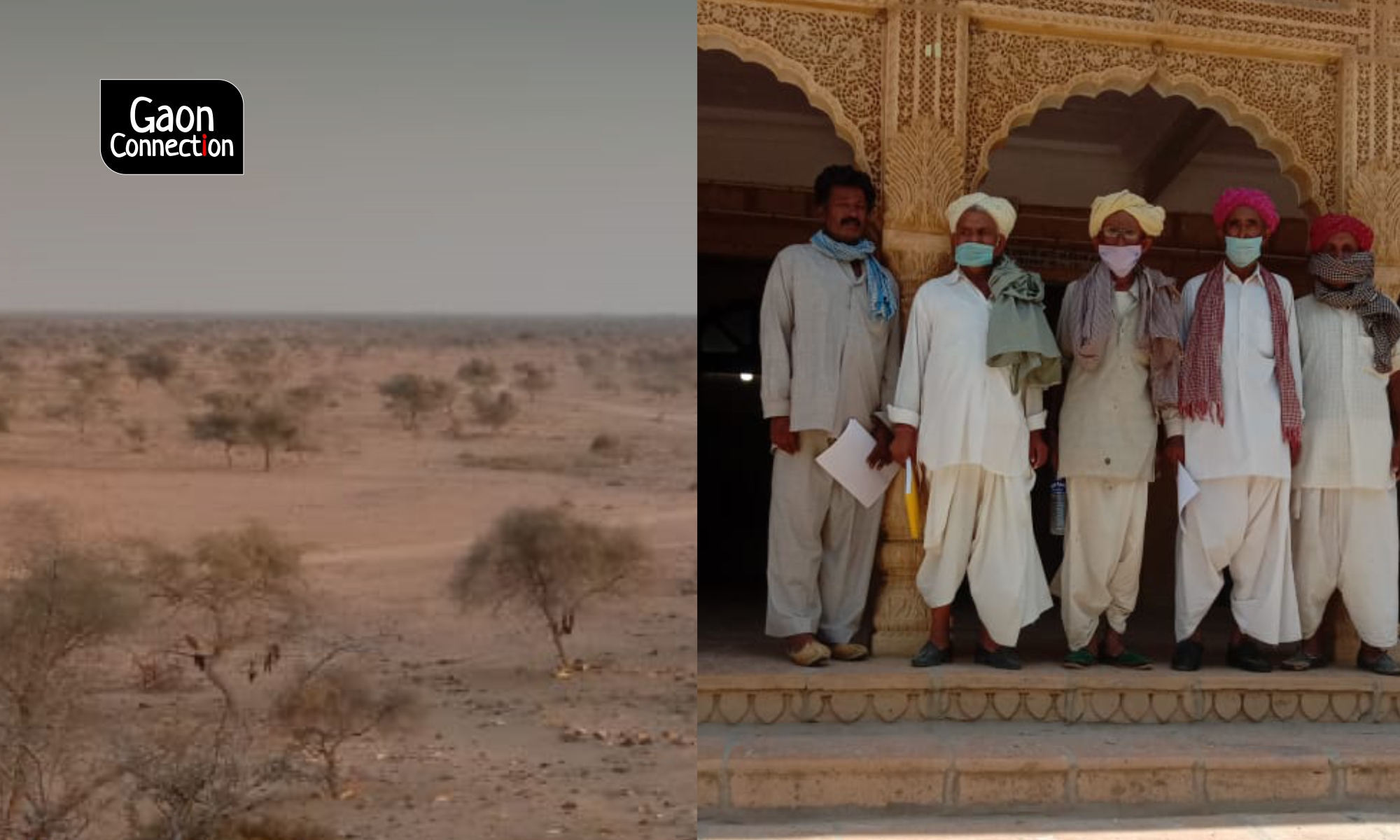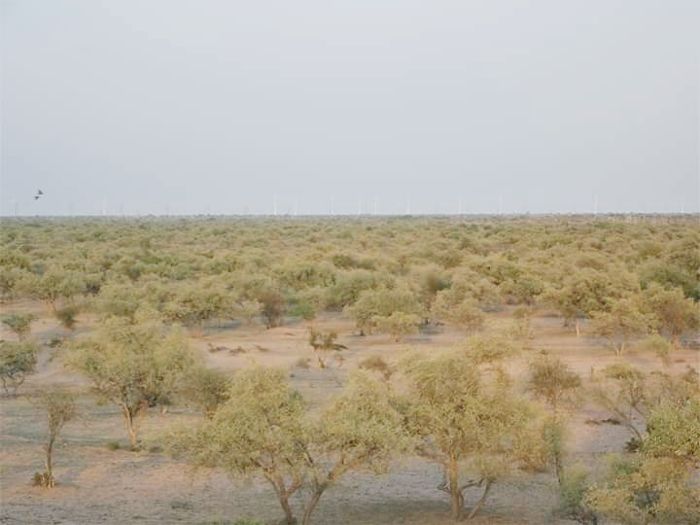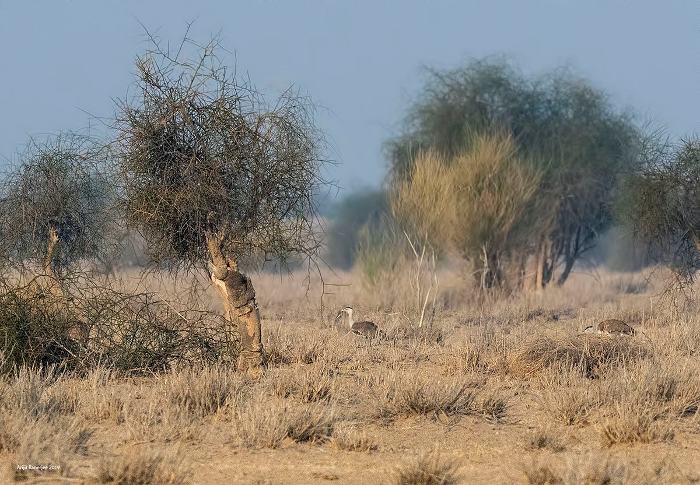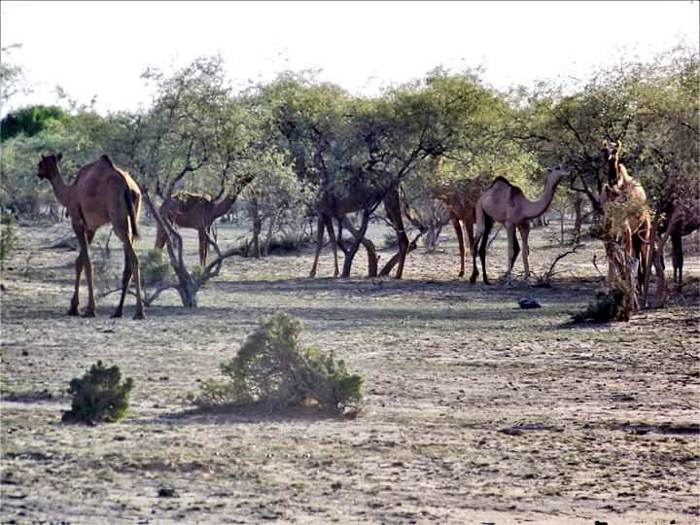Rajasthan: Camels and sheep to face a fodder crisis as about 600-year-old Oran is being uprooted
At this Oran in Samvata village in Jaisalmer, trees are being cut for the installation of a solar plant. Villagers living in the vicinity are fiercely opposing this


In Rajasthan, more than 5,000 camels and 30,000 sheep are set to face a fodder crisis. Thousands of wild animals and birds are likely to get affected. Millions of plants and trees are likely to be chopped off, and the land is being dug up with JCBs.
All this is happening at the 610-year-old Oran of Shri Degarai Mata Temple in Samvata village in Jaisalmer. In Rajasthan, the tradition of Oran has been observed for centuries, whereby groves are left in the name of folk deities. Here, cutting trees is prohibited and any kind of cultivation is completely banned.
Oran has been derived from the Sanskrit word ‘aranya’, which means forest. Oran consists of old trees of different local varieties like Rohira, Bordi, Kankadi, Kumat, Babul and Ker. Bushes like Aak, Khimp, Saniya, Bur, Nagphani and Thor, and grass varieties like Sevan, Dhaman, Motha, Tumba, Gokhru, Saanthi and Doob etc are present here. It is also the habitat of many animals and birds like Goravan — the state bird of Rajasthan — pheasant, deer, Jackal, etc. If the Oran ceases to exist, what will happen to the flora and fauna that it supports?

This particular Oran in Jaisalmer doesn’t permit any felling of trees or cultivation. The grove provides fodder for camels and sheep belonging to the farmers of dozens of nearby villages. However, for the past few days, trees are being cut indiscriminately and digging by JCBs is going on in the Oran for the installation of a solar plant. If the Oran ceases to exist, what will happen to the camels and sheep farmers, especially when the number of camels is already dwindling?
Sumer Singh Bhati, who lives in Samvata village and owns 400 camels, informed: “We have the largest Oran in Rajasthan. It is a sacred site. No tree can be cut and no one can cultivate anything here. It is a pasture. About 600 years ago, the king of Jaisalmer, had donated this land to the temple. The copper plate upon which the deed had happened is still with us. In 2004, when the land was reclaimed by the government, several villagers had together tried and restored 23,000 bighas under the name of the temple. Since then, we have been constantly making efforts. Over the years, many corporates have arrived here.”
People from dozens of villages are coming forward in the battle to save their Oran. They have also submitted a memorandum at the district magistrate’s office in Jaisalmer to disallow the solar plant.

Despite the fierce heat of the desert, the Khejari tree remains green and presently there is a shortage of green fodder for cattle. Animals get green fodder from these trees. Amrita Vishnoi had given up her life to save the very Khejari trees which are being chopped off in the Oran.
There are more than 5,000 camels and more than 30,000 sheep belonging to the numerous villages like Samwata, Achala, Bhikhsar, Bhopa, Mulana and Karda. Oran is the only source of fodder for these animals.
“We are already facing a reduction in the number of camels. What will the remaining camels eat if the pastures are not there?” asked Sumer Singh Bhati. He added: “I have 400 camels and in the 12 villages nearby, 5,000 camels and 30,000 sheep are dependent on the Oran. Cattle is also dependent on the Oran. If the Oran is not spared, there would be no place for our camels to graze.”
When contacted, the Minister of State for Environment and Forests, Sukhram Vishnoi, said over the phone: “I am not aware of the solar plant and Oran’s occupation, let me check upon this.”

Camel is also the state animal of Rajasthan that is home to the highest camel population in the country. In the past few years, their number has been decreasing continuously due to poaching, sickness and the lack of grassland. As per the 20th animal census, there are 2.51 lakh camels in the country, while as per the 19th animal census held in 2012, there were more than 4 lakh camels. As per the 19th cattle census in Rajasthan, in 2012, there were 3. 25 camels. The number has come down to 2.12 lakh in the 20th census in 2019.
There are many small ponds in these biodiversity-rich Orans. Jaisalmer receives very little rain. Rain water is collected in these ponds and animals are dependent on these ponds. Rajasthan has 25,000 Orans with a total area of about 6,00,000 hectares. About 1,100 major Orans are spread over an area of 1,00,000 hectares. Of these, about 5,370 sq km are of Orans in the Thar Desert.
Sumit Dukiya, the assistant professor of the Environment Department at Guru Gobind Singh Indraprastha University, New Delhi, has been working towards the conservation of Rajasthan’s state bird — Goravan — for the past several years. Sumit said: “The main profession of the people in the villages here is camel and sheep rearing, and it is with the help of this Oran, they rear camels and sheep. If the Oran does not survive, where will they take their cattle? These are the habitat of many animals and birds, where they will go?”
Because Oran is considered to be the place of the total deity, the right to Oran is also with the Temple Committee. “Our Oran is several hundred years old, we villagers are constantly struggling to save it, our sole request to the government is to protect it. It houses a lot of wild animals, vegetation and ponds. This is the centre of our faith,” says Girdhar Singh, the priest of the Degarai temple.

